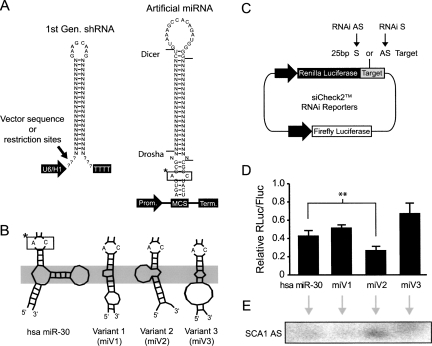FIGURE 1.
Optimization of the human miR-30 shuttle. (A) General structures of shRNAs and artificial miRNAs (N's correspond to the siRNA-duplex region with sense and antisense being 5′ and 3′, respectively). Here, the antisense sequences are designed to target SCA1, HD, or GFP transcripts. Hash marks indicate the known major Drosha and Dicer cleavage sites of human miR-30 (Lee et al. 2003; Zeng and Cullen 2003; Silva et al. 2005). Processing sites of many shRNAs are unknown and vary based on the presence of short flanking sequences. (*) Boxed sequence is for orientation purposes in the panel. (B) Artificial miRNA variants were generated by altering the nearby flanking sequences, and portions of the predicted mFOLD (Zuker 2003) structures within the stem-base are shown. Instability (i.e., single-stranded nature) within the gray-shaded region may promote Drosha binding and cleavage (Zeng and Cullen 2005; Han et al. 2006). These variants contain identical RNAi sequences and structures in regions above the gray-shaded box. (C) Cartoon depicting RNAi reporters, generated by inserting target sequences into the 3′ UTR of Renilla luciferase. Reporter plasmids also contain a Firefly luciferase expression cassette for normalization. (D) Silencing activity of miR-30 variants. Artificial miSCA1 variants and RNAi reporter expression plasmids were cotransfected into HEK293 cells, and Dual-Glo Luciferase assays were performed after 24 h. Results of two independent experiments (each n = 3) are shown as mean±SEM relative to mock-treated (i.e., promoter only) controls and demonstrate that variant 2 (miV2) is the most effective artificial miRNA (even more effective than human miR-30, ** = P < 0.01). (E) Small transcript Northern blot was performed at 48 h post-transfection of miRNA variant expression plasmids into HEK293 cells. Results show that miV2 yields more mature antisense RNA (SCA1 AS) compared to the other artificial miRNA variants including the natural miR-30 shuttle.

